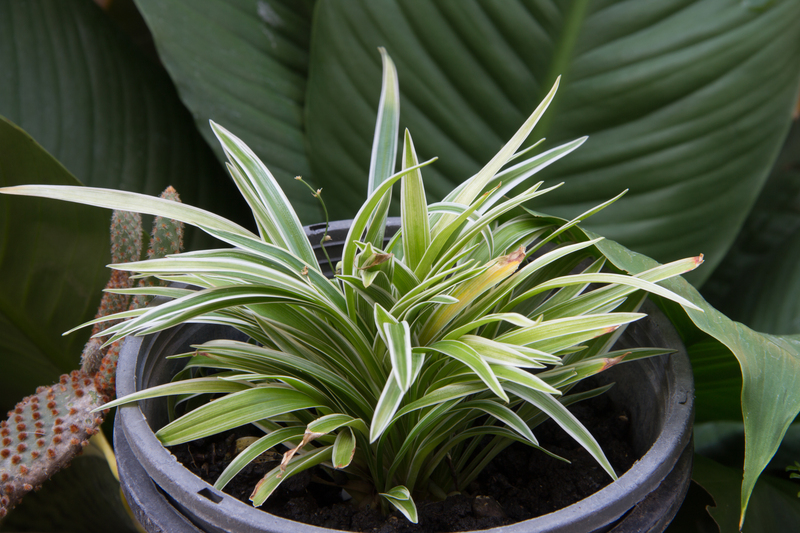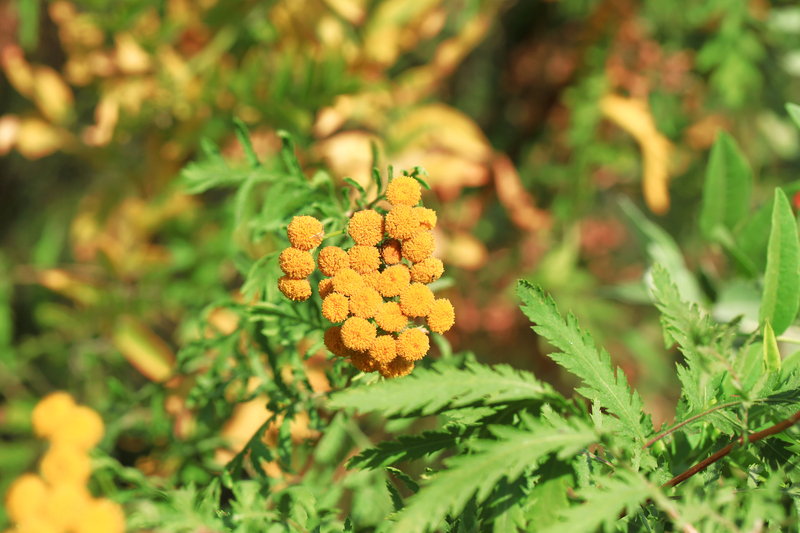Seeds of Change: The Role of Gardening in Climate Action
Posted on 14/06/2025
Seeds of Change: The Role of Gardening in Climate Action
As climate change accelerates around the globe, increasing numbers of people are seeking meaningful ways to contribute to environmental stewardship. While governments and corporations play pivotal roles, individual and community actions are equally significant. Among the most accessible and impactful strategies is gardening--a timeless human activity that offers modern solutions to combat the climate crisis. In this comprehensive article, we explore how gardening for climate change can empower communities, sequester carbon, foster biodiversity, and pave the way toward a more sustainable future.

The Science Behind Gardening and Climate Change
At its core, gardening for climate action is not merely about growing plants, but it's an ecosystem-level intervention. Plants naturally absorb carbon dioxide (CO2), the primary greenhouse gas, from the atmosphere during photosynthesis. By increasing green spaces--whether it's a backyard plot, a rooftop garden, or a community greenway--gardeners directly help to absorb excess CO2. But the climate-friendly benefits of gardening extend much further:
- Soil Health Improvement: Healthy, well-managed soils act as major carbon sinks. Practices like composting, mulching, and using organic amendments enhance soil organic matter and carbon storage.
- Biodiversity Support: Gardens provide habitats for pollinators, birds, and beneficial insects, supporting resilience within local ecosystems.
- Urban Cooling: Plants and trees in gardens lower local surface and ambient temperatures, mitigating the urban heat island effect.
- Water Conservation: Efficient gardening techniques reduce runoff, enhance groundwater recharge, and decrease the need for energy-intensive water systems.
- Food System Resilience: Edible gardens decrease reliance on industrial agriculture, reducing food miles and cutting emissions linked to transportation and storage.
These eco-friendly gardening practices not only address climate concerns but also create healthier, more vibrant communities. Let's delve deeper into each aspect.
1. Carbon Sequestration and Improving Soil Health
One of the most critical climate benefits of gardening is its potential for carbon sequestration. Plants draw CO2 from the air, storing it in their tissues and, crucially, transferring a portion to the soil through their roots. When gardeners adopt sustainable gardening methods, such as minimal tilling, cover cropping, and composting organic materials, they maximize carbon storage and minimize its release.
- No-till Gardening: Reduces soil disturbance, preserving carbon-rich soil structure, and protecting microorganisms key for breaking down organic matter.
- Composting: Converts plant waste, kitchen scraps, and yard trimmings into nutrient-dense humus, increasing soil carbon and fertility while diverting waste from landfills (which emit methane).
- Cover Cropping: Planting legumes, grasses, or clovers during fallow periods protects soil, captures carbon, and adds organic matter when tilled back in.
According to soil scientists, carbon farming gardening techniques can increase soil organic matter by 1-3% per year, which is significant on a global scale. By making these small changes, every gardener helps lock atmospheric carbon securely underground.
2. Promoting Biodiversity and Ecological Resilience
Climate change threatens millions of species with extinction due to habitat loss and ecosystem disruption. Gardening for climate adaptation inherently supports biodiversity conservation through the creation and restoration of diverse habitats. Gardens, especially when planted with native species, act as important refuges for wildlife.
- Pollinator Gardens: Planting milkweed, sunflowers, lavender, and wildflowers attracts bees, butterflies, and hummingbirds, supporting essential pollination services.
- Water Features: Small ponds or birdbaths provide necessary hydration and shelter for birds, frogs, insects, and other creatures.
- Native Planting: Selecting plants indigenous to your region requires less irrigation, fewer chemicals, and ensures compatibility with local fauna.
- Hedgerows and Buffer Strips: Dense plantings around garden edges create travel corridors and nesting grounds for wildlife.
By choosing climate-resilient gardening techniques--like cultivating mixed plantings (polycultures) instead of monocultures--gardeners increase ecological resilience, which helps both wildlife and human communities weather climate extremes.
3. Cooling Cities with Urban Gardens
Cities are particularly vulnerable to the impacts of rising temperatures, experiencing "heat islands" due to concrete, asphalt, and sparse vegetation. Urban gardening for climate mitigation is essential for reversing this trend. Even relatively small increases in urban planting can reduce local temperatures by several degrees, moderate air pollution, and improve overall air quality.
- Green Roofs and Walls: Vegetated rooftops insulate buildings, shade surfaces, lower energy use, and absorb rainfall, reducing runoff and city heat.
- Community Gardens: Transforming vacant lots or rooftops into green spaces provides cooling benefits while supplying fresh produce and strengthening neighborhood bonds.
- Shade Trees and Vines: Planting fast-growing species creates natural shade structures around homes and sidewalks, improving comfort during heatwaves.
By greening urban spaces, gardeners actively contribute to climate adaptation in their neighborhoods, making cities healthier, more pleasant places to live.
4. Gardening for Water Conservation
Climate change intensifies both drought and deluge, stressing water supplies and increasing the risk of flooding. Climate-smart gardening designs minimize water usage, capture rainfall, and build drought resilience. Effective strategies include:
- Xeriscaping: Landscaping with low-water-use (drought-tolerant) plants and efficient irrigation.
- Rain Gardens: Depressions planted with deep-rooted natives collect and filter stormwater, reducing runoff and recharging groundwater.
- Mulching: Applying organic material atop your soil slows evaporation, keeps roots cool, and feeds soil microbes.
- Drip Irrigation: Soaker hoses and drip lines deliver water right to plant roots, decreasing waste.
These water-wise approaches not only protect vital resources but also help gardens withstand increasingly unpredictable climate patterns.
5. Food Gardens: Shrinking Your Carbon Footprint
Our food system is a major contributor to global greenhouse gas emissions. From fossil-fueled tractors to long-distance shipping, the carbon costs of industrial agriculture are immense. Edible gardening for climate change reduces these impacts on multiple fronts:
- Shortened Supply Chain: Homegrown produce eliminates "food miles," or transportation emissions.
- Organic Practices: Using compost and natural pest control eliminates fossil-fuel-based fertilizers and pesticides.
- Crop Diversity: Growing heirloom and region-suited varieties increases local food security and bolsters resilience to pests and disease.
- Waste Reduction: Gardeners harvest as needed, avoiding the wastage and spoilage common in industrial food systems.
In addition to shrinking your personal carbon footprint, home and community gardens promote food justice by increasing accessibility and encouraging healthy, sustainable diets.
Building Community and Inspiring Change
The climate crisis demands not only technological solutions, but also a transformation of how we relate to the planet and one another. Gardening's role in climate action is particularly potent because it draws people together--the very essence of community resilience.
- Education and Engagement: Community gardens and schools educate participants about sustainable practices, food systems, and environmental stewardship.
- Social Cohesion: Shared gardening projects strengthen neighborhood ties and foster collaboration.
- Mental Health: Connecting with nature through gardening reduces anxiety, stress, and fosters a sense of agency in tackling global challenges.
- Collective Action: Local gardening initiatives inspire larger-scale movements, changing policies and urban planning priorities.
As more people take up gardening for climate impact, they form networks of grassroots change--seeding hope and practical solutions in the face of daunting odds.
How You Can Start: Climate-Friendly Gardening Tips
Whether you have a few pots on a balcony or a sprawling backyard, everyone can participate in climate-positive gardening. Here are some easy, high-impact steps to get you started:
- Grow Native Plants: They're adapted to local conditions and require less water and care.
- Compost Your Waste: Turn kitchen scraps and yard debris into rich fertilizer, keeping organics out of landfills.
- Use Mulch: Insulate soil, retain moisture, and feed soil life naturally.
- Plant Trees or Shrubs: Even small trees absorb huge amounts of CO2 across their lifetimes.
- Avoid Chemicals: Minimize use of synthetic fertilizers and pesticides to protect beneficial organisms.
- Practice Water-Smart Gardening: Water deeply but infrequently, install rain barrels, and group plants by water needs.
- Share Seeds and Knowledge: Swap seeds with neighbors, start a seed library, and teach others what you learn.
By embedding climate action in your gardening practices, you create a living ripple effect--changing not just your own plot, but the broader ecological and social landscape.

The Future: Scaling Gardening for a Climate-Resilient World
Gardening is not a panacea for climate change, but it is a scalable, inclusive, and practical solution. Many cities and countries are now recognizing the value of climate-action gardening and integrating it into urban planning, education, and sustainability policies.
- Incentives and Grants: Governments are funding green space creation, community gardening, and reforestation projects.
- Permaculture and Agroecology: These advanced systems maximize yields and climate resilience with minimal external inputs.
- Research and Innovation: New plant varieties, biochar, and regenerative techniques promise ever-greater benefits for climate, food, and biodiversity.
- Citizen Science: Gardeners are contributing data on plant phenology, wildlife sightings, and soil health, aiding climate research efforts worldwide.
If current trends continue, gardening for climate change adaptation could play a foundation role in how cities and communities buffer themselves against a rapidly warming world.
Conclusion: Every Seed Counts
In the face of daunting environmental challenges, gardening for climate action offers an extraordinary blend of hope, practicality, and empowerment. Every seed planted, compost pile turned, and community garden started represents a meaningful step toward a healthier climate and a more resilient society. Seeds of change are already sprouting in backyards, balconies, and city parks around the world. The time to nurture them is now--so go ahead and plant yours.
Ready to become part of the climate solution? Grab your trowel, pick up some seeds, and join the global gardening movement for a cooler, greener future!
To learn more about climate action through gardening, explore local gardening communities, and share your own journey, connect with organizations and resources committed to eco-friendly gardening for climate change. Together, we can sow the seeds of a brighter, more sustainable world.

